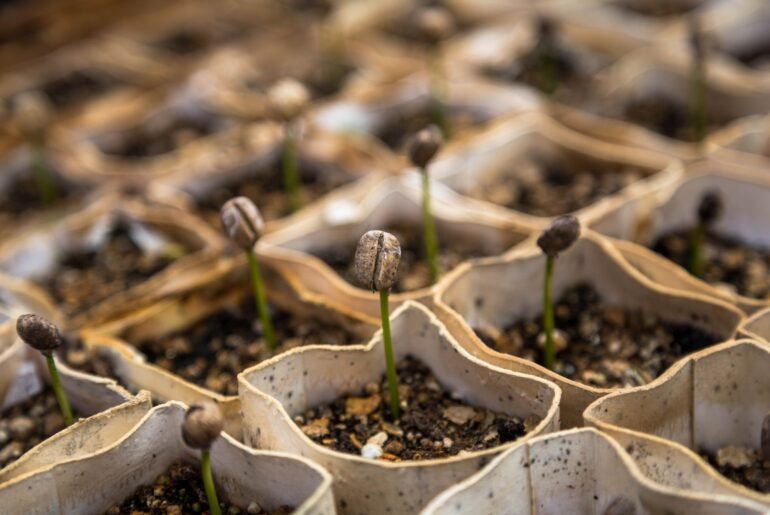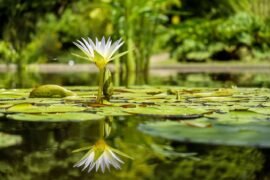Mulch may be one of the most commonly used terms when it comes to landscaping, but does anyone really know what it is? Even if you know what it looks like, you may not know what it is actually made from and that there are multiple types of mulch. So before you start your next landscaping project, learn a bit about mulch and how to best use it in your yard to make make your landscape pop and protect your home.
What Is Mulch?
The most basic definition of mulch is a layer of material placed over the top of surface soil. Mulch is used for both practical and aesthetic reasons. A layer of mulch can conserve soil moisture, keep the soil fertile, prevent erosion, keep the soil cool and safe from extreme heat, and prevent weeds from popping up in your backyard edging. From an aesthetic standpoint, dyed mulch creates an often colorful border between your house and yard.
Different Kinds of Mulches
Mulch types are broken down into two different categories, organic and inorganic. Each material has different uses though many can be used for the same purpose. If you don’t have a favorite mulch for your landscape bed already this may give you an idea of where to start.
Organic Mulch Material
Compost, Grass Cuttings, Newspaper, Pine Needles, Shredded Leaves, and Straw
These organic materials are almost exclusively used to fertilize plants and are often choices for homes with many plants and bushes around the landscape. This mulch breaks down fast and needs to be replaced often. Organic mulch is a must-have for the organic gardener because it creates healthy soil and promotes healthy soil without the need for harsh chemicals.
Bark
Wood chips from tree bark are probably the most common mulch there is and what most people think of as mulch. It is often colored mulch, can be bark chips or shredded bark, and will last significantly longer than other organic mulch, but it eventually breaks down. The bark is popular because it still offers some nutrients to your landscaping, but it is aesthetically appealing and has other benefits like repelling bugs.
Inorganic Mulch Material
Stone
Stone mulches are a popular option because they are relatively inexpensive compared to other inorganic materials and do a good job of blocking out stubborn weeds.
Recycled glass
Recycled glass is machine-tumbled to dull the edges, so there is no fear of sharp glass surrounding your home. This is a popular mulch because it has a luxurious and beautiful visual appearance, but that appeal comes at a cost.
Rubber Mulches
Rubber is a popular option because it mimics the look of bark mulch but never needs to be replaced.
Landscape Fabric
Landscape fabric is often a barrier that is placed before you put down the actual mulch to control weeds. It’s sometimes made of black plastic sheeting, but more often it is made from black fabric.
When to Use Mulch
Knowing when to lay mulch can be tricky, and it varies depending on what you are using it for. If you are laying down mulch to feed plants or garden beds, you want to do it in mid to late spring and only start with a thin layer to allow seedlings to poke through. Once the seeds have a strong base, you can add more mulch to continue to feed them.
If you are laying down mulch to prevent weeds, it is best to do it early in the spring to keep any budding weeds from poking through.
Another little-known time for laying down new mulch is the beginning of winter. After the first frost, clear off any old mulch and lay down new mulch. This insulates dormant plants and protects them from fluctuating winter weather, so they don’t come out of dormancy too early.
Pros and Cons of Mulching
The benefits of mulch are many, but it can also have some drawbacks; it is vital to know the good and bad before deciding what’s right in your yard.
Pros
- Prevents damage from heat and sun
- Retains moisture which is pivotal in times of drought
- Block weed growth
- Prevents soil erosion
- Organic mulch provides
- Prevent garden bed rot by lifting fruit and vegetables off the ground
- Creates a barrier that keeps out some bugs
- Creates an aesthetically pleasing transition between the lawn and the home
- Regulates soil temperature
Cons
- Mulch creates a cool dark place where bugs like slugs and earworms love to live
- Organic mulch can introduce new species of weeds to your garden
- Organic mulch needs to be replaced often
- The same mechanisms that prevent weeds can also stifle seedling growth
- Some mulches that are dyed for aesthetic appeal can leach toxins into the garden
The Dos and Don’ts of Mulching
Now that you know what can go wrong with mulching, here are a few tips to prevent poor outcomes and make your mulch work for you.
Dos
- Apply mulch every year to get the most benefits
- Use organic mulch for gardens, flower beds, and tree trunks
- Pull any weeds before you mulch
- Use mulch as an accent to make your landscape pop
- Ensure that your mulch is pet-safe
Don’ts
- Cover an area in more than three inches of mulch
- Leave any unmulched soil
- Use inorganic mulch like plastic mulch in the vegetable garden – it may look nice, but it can leach toxins into your garden
Why You Should Be Using Mulch
Now you know the who, what, when, and where of mulch, but you may still be questioning why. You don’t have a garden, and your trees and shrubs seem to get along fine without it, but a lot goes on underneath the soil surface, and there are many reasons why you want to use mulch even if you don’t think you need it.
Plantlife can change quickly, which is why it is essential to be proactive when using mulch to block weeds and feed plants and gardens. In addition, mulch for landscaping will immediately improve your curb appeal and make your home more appealing when it is time to sell.
More than anything, you should use mulch on your property because it is an inexpensive and easy way to maintain your landscaping.
Get Mulching
Spring is always around the corner, and there is no better time than now to be planning your lawn care. Whether you are just looking for some curb appeal or looking to take your vegetable garden to the next level, there is mulch out there for you. With this basic knowledge, you will have the best landscape design on the block, and you’ll be looking for more places to put mulch.
FAQs
How Much Mulch Should I Use?
There is no hard and fast rule about the volume of mulch to use, but the ground should be covered in an even layer of mulch, and never pile it on more than three inches deep because it will stifle any plant growth.
To Calculate how much bulk mulch you will need for a project, use these steps:
- Measure the area you need to cover.
- Multiply the length in feet by the width in feet.
- Divide that amount by 27.
- Divide that amount by 12.
- Multiply by the thickness in inches you want of ground cover.
- The final number is the approximate number of cubic yards of mulch you need for your project.
You don’t want to waste materials, but you may end up with a few extra feet of mulch. Any additional mulch can be placed around trunks of trees to give some added nutrients to their roots systems.
Do I Need to Remove Old Mulch?
It is always good to remove the old mulch layer before laying down the new material because you don’t want it to prevent nutrients from the new material from getting to the soil. Also, some mulch can become toxic over time; so it is a good idea to get any potentially harmful mulch out.
Is All Mulch the Same?
Not all mulch products are the same; they can vary significantly in safety and quality depending on the type of mulch. If you have kids or pets around, make sure that your mulch is safe for the occasional tasting. You also want to ensure that your mulch is from a reputable source; cheap mulches can come with all kinds of garbage sewn in; including weed seeds which defeats the whole purpose of mulching.




Comments are closed.